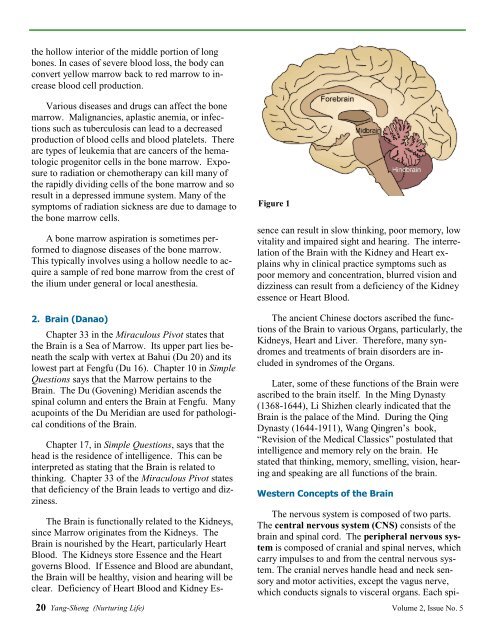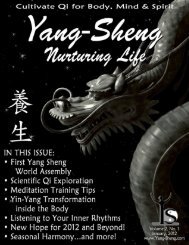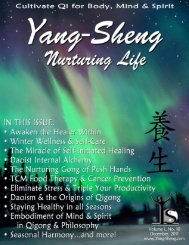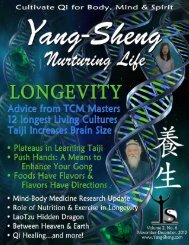Download - Yang-Sheng
Download - Yang-Sheng
Download - Yang-Sheng
Create successful ePaper yourself
Turn your PDF publications into a flip-book with our unique Google optimized e-Paper software.
the hollow interior of the middle portion of long<br />
bones. In cases of severe blood loss, the body can<br />
convert yellow marrow back to red marrow to increase<br />
blood cell production.<br />
Various diseases and drugs can affect the bone<br />
marrow. Malignancies, aplastic anemia, or infections<br />
such as tuberculosis can lead to a decreased<br />
production of blood cells and blood platelets. There<br />
are types of leukemia that are cancers of the hematologic<br />
progenitor cells in the bone marrow. Exposure<br />
to radiation or chemotherapy can kill many of<br />
the rapidly dividing cells of the bone marrow and so<br />
result in a depressed immune system. Many of the<br />
symptoms of radiation sickness are due to damage to<br />
the bone marrow cells.<br />
A bone marrow aspiration is sometimes performed<br />
to diagnose diseases of the bone marrow.<br />
This typically involves using a hollow needle to acquire<br />
a sample of red bone marrow from the crest of<br />
the ilium under general or local anesthesia.<br />
Figure 1<br />
The Brain is functionally related to the Kidneys,<br />
since Marrow originates from the Kidneys. The<br />
Brain is nourished by the Heart, particularly Heart<br />
Blood. The Kidneys store Essence and the Heart<br />
governs Blood. If Essence and Blood are abundant,<br />
the Brain will be healthy, vision and hearing will be<br />
clear. Deficiency of Heart Blood and Kidney Essence<br />
can result in slow thinking, poor memory, low<br />
vitality and impaired sight and hearing. The interrelation<br />
of the Brain with the Kidney and Heart explains<br />
why in clinical practice symptoms such as<br />
poor memory and concentration, blurred vision and<br />
dizziness can result from a deficiency of the Kidney<br />
essence or Heart Blood.<br />
2. Brain (Danao)<br />
Chapter 33 in the Miraculous Pivot states that<br />
the Brain is a Sea of Marrow. Its upper part lies beneath<br />
the scalp with vertex at Bahui (Du 20) and its<br />
lowest part at Fengfu (Du 16). Chapter 10 in Simple<br />
Questions says that the Marrow pertains to the<br />
Brain. The Du (Govening) Meridian ascends the<br />
spinal column and enters the Brain at Fengfu. Many<br />
acupoints of the Du Meridian are used for pathological<br />
conditions of the Brain.<br />
Chapter 17, in Simple Questions, says that the<br />
head is the residence of intelligence. This can be<br />
interpreted as stating that the Brain is related to<br />
thinking. Chapter 33 of the Miraculous Pivot states<br />
that deficiency of the Brain leads to vertigo and dizziness.<br />
The ancient Chinese doctors ascribed the functions<br />
of the Brain to various Organs, particularly, the<br />
Kidneys, Heart and Liver. Therefore, many syndromes<br />
and treatments of brain disorders are included<br />
in syndromes of the Organs.<br />
Later, some of these functions of the Brain were<br />
ascribed to the brain itself. In the Ming Dynasty<br />
(1368-1644), Li Shizhen clearly indicated that the<br />
Brain is the palace of the Mind. During the Qing<br />
Dynasty (1644-1911), Wang Qingren’s book,<br />
“Revision of the Medical Classics” postulated that<br />
intelligence and memory rely on the brain. He<br />
stated that thinking, memory, smelling, vision, hearing<br />
and speaking are all functions of the brain.<br />
Western Concepts of the Brain<br />
The nervous system is composed of two parts.<br />
The central nervous system (CNS) consists of the<br />
brain and spinal cord. The peripheral nervous system<br />
is composed of cranial and spinal nerves, which<br />
carry impulses to and from the central nervous system.<br />
The cranial nerves handle head and neck sensory<br />
and motor activities, except the vagus nerve,<br />
which conducts signals to visceral organs. Each spi-<br />
20 <strong>Yang</strong>-<strong>Sheng</strong> (Nurturing Life) Volume 2, Issue No. 5













